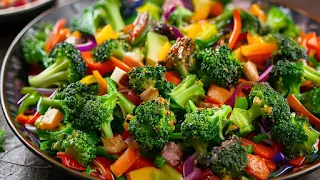Is There a "Wrong" Way to Eat Broccoli?
You know, we often hear that broccoli is a superhero food, packed with incredible benefits, right? And it's true! It's often called the "King of Anti-Cancer Foods" for good reason. You can totally eat broccoli raw, from the flower heads to the leaves and stem, which is pretty neat because it's related to things like cabbage and kale that we eat raw too. Here's the thing though, while eating it raw can get you the most sulforaphane, the key anti-cancer compound, let's be honest, the taste isn't always everyone's favorite. This leads many of us to cook it, and that's where things get interesting.
Boiling broccoli might seem like the easiest way, you know, just tossing it in hot water. But if you boil it for too long, that amazing sulforaphane, which gives broccoli its antioxidant and anti-cancer punch, can actually disappear. A study published in the Journal of the East Asian Society of Dietary Life, by Professor Ki-Taek Lee's team at Chungnam National University, found that after just one minute in boiling water, sulforaphane was gone. What's surprising is that even when steaming, a method often recommended, heating for three minutes or more dramatically reduced sulforaphane, leaving less than a tenth. So, yeah, how you cook it really matters!
To really get the good stuff, steaming is the way to go, and even then, keeping it short, around a minute, is best. And hey, remember to wash it well because it can have impurities and larvae! Running water isn't enough due to a waxy surface, so soaking it upside down for at least 15 minutes helps dislodge them.
Beyond Sulforaphane: What Else Does Broccoli Offer?
Now, you might be thinking, if I cook it and lose some sulforaphane, is it even worth it? Absolutely! Sulforaphane is important, sure, but it's not the only amazing thing in broccoli. This veggie is loaded with a whole bunch of other good-for-you stuff. We're talking about things like:
- Vitamin C
- Beta-carotene
- Folate
- Vitamin K
- Potassium
- Calcium
- Selenium
- Rutin
- Quercetin
- Dietary fiber
That's a seriously impressive lineup, isn't it? What's fantastic is that many of these nutrients stick around even when you heat or boil broccoli. So, even if you're not getting the maximum sulforaphane from boiling, you're still getting a wealth of other beneficial compounds. And here's a little secret: don't toss the stem! From my experience, many people just cut off the florets, but the stem actually contains more nutrients. Just remember to peel off the tough outer layer. It's totally fine to enjoy broccoli in different ways depending on what you're craving.
The Secret Ingredient for Boosting Broccoli's Power?
This is where things get really interesting! Did you know you can actually boost the benefits of broccoli just by pairing it with the right foods? It sounds a little wild, but it's true! Research from Professor Elizabeth Jeffery's lab at the University of Illinois suggests that eating broccoli with other spicy plants in the same family can actually help create and absorb more sulforaphane. We're talking about its cousins like cabbage, radish, mustard greens, kale, mustard, and even wasabi.
Think about it: the stuff that turns into sulforaphane, called glucoraphanin, doesn't disappear when you boil broccoli. And the enzyme that helps convert it into sulforaphane, myrosinase, is found in abundance in broccoli's spicy relatives like mustard and wasabi. So, instead of dipping your steamed broccoli in something typical, try a little mustard sauce or wasabi. It's a neat trick to get more of that amazing sulforaphane!
Also, if you're lightly stir-frying broccoli, using olive oil is a great idea. Beta-carotene, another nutrient in broccoli, is a fat-soluble vitamin, meaning it absorbs better when eaten with fat. Olive oil, with its many benefits, is a perfect choice.
Making Broccoli Delicious: Tips and Tricks
So, how do we make this super healthy veggie something you and your family actually want to eat? I've found that simply putting plain steamed broccoli on the table doesn't always get the best reaction. The trick is to get creative and hide it in dishes people already love! Let's talk about making it more appealing. You can totally add broccoli to all sorts of flavored dishes. It's great in bulgogi. It pairs wonderfully with stir-fries, maybe even with cashews like you see in some Southeast Asian dishes. Want a surprising place to put it? Try adding it to tteokbokki! People who don't like cabbage might not even notice it's there. I've also heard it's absolutely delicious in dakgalbi.
Don't be afraid to experiment and add broccoli to various meals. Even though it's a common sight on Korean tables, knowing how to maximize its benefits makes it even more special. Before you cook, remember to give it a good wash! After soaking, you can even use flour in a mixing bowl to help absorb any remaining dust and impurities, then rinse again with clean water. Give it a try - you might be surprised at how easy it is to make broccoli a family favorite!


